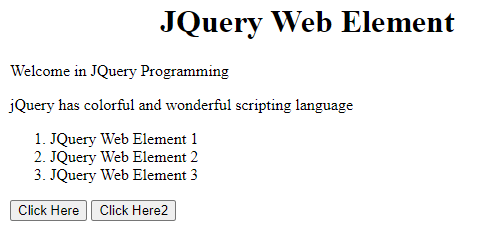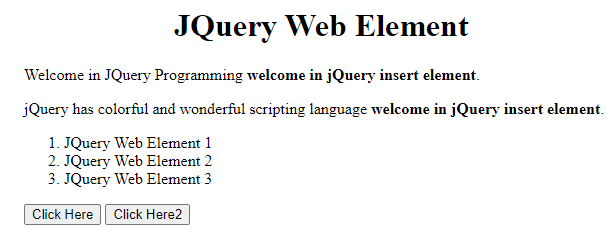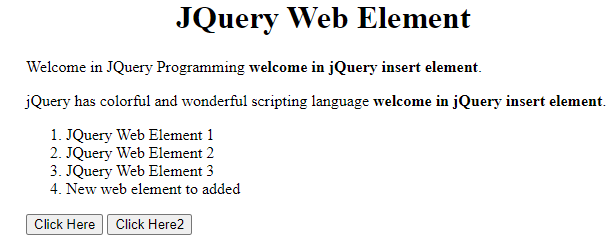Updated March 30, 2023

Definition of jQuery insert element
JQuery provides the different types of functionality to the user, in which that insert element is one, the functionalities that are provided by the jQuery. Normally it provides different methods that mean we can insert HTML content before a specified element or we can insert HTML content after the specified element as per user requirements. jQuery consists of different methods and with help of this method, we can perform different operations as per user requirements. So here we can use different methods for inserting elements such as append(), HTML(), text(), before(), after(), wrap() and prepend(). We can use any method and perform any operations.
Overview of jQuery insert element
Now let’s see the different methods of jQuery insert element as follows.
1. insertAfter():
This is the first method of inserting elements in jQuery, by using this method we can insert the web element after the specified element that we want. The HTML content will be introduced after each event of the predestined part.
Syntax
$(specified required html content).insertAfter(specified target element)Explanation
In the above example, we use different two type’s parameters as follows.
- Specified required HTML content means actual content that we need to append after the specified target content or we can say that web element.
- specified target element means specified endpoint of HTML page.
2. insert prepend():
The prepend() strategy is an inbuilt technique in jQuery which is utilized to embed a predetermined substance toward the start of the chosen component.
Insert web element before specified target element ():
The jQuery before() method is used to implant content before they pick parts. The previously() and insertBefore() two strategies are used to play out a similar task. The essential differentiation between them is in semantic design and the circumstance of the substance and the goal.
Insert web element wrap():
The wrap() procedure is an inbuilt method by jQuery which is used to overlay the predefined part over the picked part.
Insert any plain text():
This methodology is used to set or return the text content of the part. While setting the substance, it overwrites the substance of the huge number of composing parts. The returned content of text technique() is used to return the text content of each organized part.
Insert html web content():
jQuery html web content() strategy is used to change the entire substance of the picked parts: It replaces the picked part content with another substance.
Note: It is a very significant limits anyway that works in a confined locale because of its API documentation. The API documentation of the jQuery HTML work contains three strategy marks.
The principle strategy signature has no dispute, so it basically returns the HTML inside that part. The extra two imprints take a single conflict: for instance, a string or a limit that benefits a string.
How to use jQuery insert element?
Now let’s see how we can use the jQuery insert element as follows.
First, let’s see the insert append() method to insert the web element whatever we want as per user requirement as follows.
Basically, append() technique is utilized to embed a determined substance like the last kid (toward the finish of) the chosen components in the jQuery assortment.
Syntax
$(selector).append(specified web content, required function())Explanation
In the above syntax, we use the append method to insert the web element in a specified location as shown in the above syntax. In a similar way, we can use the function that we want to insert the web element in a specified location. In other words, we can say that we can use the function with HTML web content that we want inside the function as shown in the above syntax.
jQuery insert element Examples
Example
Now let’s see the different example of insert element for better understanding as follows.
<!DOCTYPE html>
<html>
<head>
<title>
Welcome in jQuery insert element
</title>
<script src="
https://ajax.googleapis.com/ajax/libs/jquery/3.3.1/jquery.min.js">
</script>
<!-- Script to append content -->
<script>
$(document).ready(function(){
$("#bttn1").click(function(){
$("p").append(" <b>welcome in jQuery insert element</b>.");
});
$("#bttn2").click(function(){
$("ol").append("<li>New web element to added</li>");
});
});
</script>
</head>
<body>
<h1 style="margin-left: 150px;">JQuery Web Element</h1>
<p>Welcome in JQuery Programming</p>
<p>jQuery has colorful and wonderful scripting language</p>
<ol>
<li>JQuery Web Element 1</li>
<li>JQuery Web Element 2</li>
<li>JQuery Web Element 3</li>
</ol>
<button id="bttn1">Click Here</button>
<button id="bttn2">Click Here2</button>
</body>
</html>Explanation
In the above example we try to execute the insert element strategy in jQuery, here we basically compose the HTML code for HTML content and we additionally add the jQuery script that is displayed. From that point forward, we made two buttons to annex the substance of anything we desire after the predefined content as displayed in the above code. In this model, we add the substance toward the finish of the section. The final output of the above program we illustrated by using the following screenshot.
Now click on the Append Here button that is the first button. After clicking on the button the result is shown in the following screenshot as follows.
Now click on the second button, after clicking on the second button the end result is shown in the following screenshot as follows.
So in this way, we can add more content as per requirement.
Now let’s see one example of append method() as follows.
<!doctype html>
<html lang="en">
<head>
<meta charset="utf-8">
<title>Welcome in JQuery Insert Element</title>
<style>
#dm {
background: rgb(131, 131, 11);
}
</style>
<script src="https://code.jquery.com/jquery-3.5.0.js"></script>
</head>
<body>
<span>This is first line of web element </span>
<div id="dm">Hi this is second line of web element </div>
<script>
$( "span" ).appendTo( "#dm" );
</script>
</body>
</html>Explanation
In the above example, we try to append the content by using id as shown; here we append Hi Read line content. The final output of the above program we illustrated by using the following screenshot.
So in this way, we can perform the different operations as per the requirement by using the insert append() method.
Conclusion
We hope from this article you learn more about the jQuery insert element. From the above article, we have taken in the essential idea of the jQuery insert element and we also see the representation and example of the jQuery insert element. From this article, we learned how and when we use the jQuery insert element.
Recommended Articles
This is a guide to jQuery insert element. Here we discuss the definition, overviews, How to use jQuery insert element, examples with code implementation. You may also have a look at the following articles to learn more –




